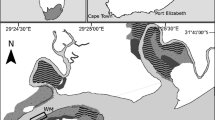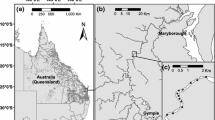Abstract
Stable isotope enrichment techniques can aid in understanding dispersal of animals. Pond-breeding amphibians often have spatially disjunct populations that depend on immigration for persistence, yet obtaining direct estimates of dispersal rates among wetlands is challenging. We enriched aquatic mesocosms with 15N to “mark” amphibian larvae and determine the feasibility of using enrichment techniques to study dispersal in pond-breeding amphibians. Because newly metamorphosed amphibians in mark-release-recapture studies may not be recaptured until adulthood, we estimated persistence of the 15N enrichment signature up to 3 years post-metamorphosis. We reared larval marbled salamanders (Ambystoma opacum) in artificial mesocosms dosed with 15NH4Cl, and maintained metamorphs on unlabeled prey for 7 months to estimate the biological half life (BHL) of 15N in tissue. Metamorphs in spiked treatments attained δ15N levels >1000 times higher than reference animals (5 ± 1‰), and levels remained ~225 times higher than controls after 7 months. The average 15N BHL was 2.49 ± 0.24 months, indicating that the elevated signature should be discernible for a minimum of 20–28 months after metamorphosis. Our results suggest that 15N enrichment is feasible for field studies of amphibian dispersal, as metamorphs will retain isotope-enriched tissues that persist until at least the second year of breeding.



Similar content being viewed by others
References
Alford RA, Richards SJ (1999) Global amphibian declines: a problem in applied ecology. Annu Rev Ecol Syst 30:133–165
Briers RA, Gee JHR, Cariss M, Geoghegan R (2004) Inter-population dispersal by adult stoneflies detected by stable isotope enrichment. Freshw Biol 49:425–431
Caetano MH, LeClair R Jr (1996) Growth and population structure of red-spotted newts (Notophthalmus viridescens) in permanent lakes of the Laurentian Shield, Quebec. Copeia 1996:866–874
Caudill CC (2003) Measuring dispersal in a metapopulation using stable isotope enrichment: high rates of sex-biased dispersal between patches in a mayfly metapopulation. Oikos 101:624–630
Clarkson BR, Schipper LA, Silvester WB (2009) Nutritional niche separation in coexisting bog species demonstrated by 15N-enriched simulated rainfall. Austral Ecol 34:377–385
Coplen TB (1996) New guidelines for reporting stable hydrogen, carbon, and oxygen isotope-ratio data. Geochim Cosmochim Acta 60:3359–3360
Craig H (1957) Isotopic standards for carbon and oxygen and correlation factors for mass-spectrometric analysis of carbon dioxide. Geochim Cosmochim Acta 12:133–149
Crumpton WG, Goldsborough LG (1998) Nitrogen transformation and fate in prairie wetlands. Great Plains Res 8:57–72
Dodd CK Jr (2013) Frogs of the United States and Canada. Johns Hopkins University Press, Baltimore
Dodds WK, Marti E, Tank JL, Pontius J et al (2004) Carbon and nitrogen stoichiometry and nitrogen cycling rates in streams. Oecologia 140:458–467
France RL, Schlaepfer MA (2000) 13C and 15N depletion in components of a foodweb from an ephemeral boreal wetland compared to boreal lakes: putative evidence for microbial processes. Hydrobiologia 439:1–6
Gamble LR, McGarigal K, Jenkins CL, Timm BC (2006) Limitations of regulated “buffer zones” for the conservation of marbled salamanders. Wetl 26:298–306
Gamble LR, McGarigal K, Compton BW (2007) Fidelity and dispersal in the pond-breeding amphibian, Ambystoma opacum: Implications for spatio-temporal population dynamics and conservation. Biol Conserv 139:247–257
Gibbons JW, Winne CT, Scott DE et al (2006) Remarkable amphibian biomass and abundance in an isolated wetland: implications for wetland conservation. Conserv Biol 20:1457–1465
Graves GR, Romanek CS, Navarro AR (2002) Stable isotope signature of philopatry and dispersal in a migratory songbird. Proc Natl Acad Sci 99:8096–8100
Greenberg CH, Tanner GW (2005) Spatial and temporal ecology of oak toads (Bufo quercicus) on a Florida landscape. Herpetol 61:422–434
Greenwald KR (2010) Genetic data in population viability analysis: case studies with ambystomatid salamanders. Anim Conserv 13:115–122
Gribsholt B, Struyf E, Tramper A et al (2007) Nitrogen assimilation and short term retention in a nutrient-rich tidal freshwater marsh – a whole ecosystem 15N enrichment study. Biogeosci 4:11–26
Hagler J, Jackson CG (2001) Methods for marking insects: current techniques and future prospects. Annu Rev Entomol 46:511–543
Hanski I, Gaggiotti OE (2004) Ecology, genetics, and evolution of metapopulations. Alsevier Academic Press, Burlington
Hanski I, Kuussaari M, Nieminen M (1994) Metapopulation structure and migration in the butterfly Melitaea cinxia. Ecology 75:747–762
Harrison MD, Groffman PM, Mayer PM, Kaushal SS (2012) Nitrate removal in two relict oxbow urban wetlands: a 15N mass-balance approach. Biogeochemistry 111:647–660
Hedges REM, Clement JG, Thomas CDL, O’Connell TC (2007) Collagen turnover in the adult femoral mid-shaft: modeled from anthropogenic radiocarbon tracer measurements. Am J Phys Anthropol 133:808–816
Hels T (2002) Population dynamics in a Danish population of spadefoot toads Pelobates fuscus. Ecography 25:303–313
Herman PMJ, Middelburg JJ, Widdows J, Lucas CH, Heip CHR (2000) Stable isotopes as trophic tracers: combining field sampling and manipulative labelling of food resources for macrobenthos. Mar Ecol Prog Ser 204:79–92
Hesslein RH, Hallard KA, Ramlal P (1993) Replacement of sulfur, carbon, and nitrogen in tissue of growing broad whitefish (Coregonus nasus) in response to a change in diet traced by δ34S, δ13C, and δ15N. Can J Fish Aquat Sci 50:2071–2076
Hobson KA, Soto DX, Paulson DR, Wassenaar LI, Matthews JH (2012) A dragonfly (δ2H) isoscape for North America: a new tool for determining natal origins of migratory aquatic emergent insects. Methods Ecol Evol 3:766–772
SAS Institute (2011) SAS system for windows, 93rd edn. SAS Institute, Cary
Jensen J, Camp C, Gibbons W, Elliott M (2008) Amphibians and reptiles of Georgia. University of Georgia Press, Athens
Lannoo M (2005) Amphibian declines: the conservation status of United States species. University of California Press, Berkeley
Lee K, Lee SY, Connolly RM (2011) Combining stable isotope enrichment, compartmental modelling and ecological network analysis for quantitative measurement of food web dynamics. Methods Ecol Evol 2:56–65
Levins RA (1969) Some demographic and evolutionary consequences of environmental heterogeneity for biological control. Bull Entomol Soc Am 15:237–240
Mariotti A (1983) Atmospheric nitrogen is a reliable standard for natural 15N abundance measurements. Nature 303:685–687
Marsh DM, Trenham PC (2001) Metapopulation dynamics and amphibian conservation. Conserv Biol 15:40–49
O’Brien JM, Hamilton SK, Kinsman-Costello LE, Lennon JT, Ostrom NE (2012) Nitrogen transformations in a flow-through wetland revealed using whole-ecosystem pulsed 15N additions. Limnol Oceanogr 57:221–234
Perret N, Pradel R, Miaud C, Grolet O, Joly P (2003) Transience, dispersal, and survival rates in newt patchy populations. J Anim Ecol 72:567–575
Porter JH, Dooley JL (1993) Animal dispersal patterns: a reassessment of simple mathematical models. Ecology 74:2436–2443
Rubenstein DR, Hobson KA (2004) From birds to butterflies: animal movement patterns and stable isotopes. Trends Ecol Evol 19:256–263
Scott DE (1994) The effect of larval density on adult demographic traits in Ambystoma opacum. Ecology 75:1383–1396
Scott DE, Komoroski MJ, Croshaw DA, Dixon PM (2013) Terrestrial distribution of pond-breeding salamanders around an isolated wetland. Ecology 94:2537–2546
Semlitsch RD (2008) Differentiating migration and dispersal processes for pond-breeding amphibians. J Wildl Manag 72:260–267
Semlitsch RD, Scott DE, Pechmann JHK (1988) Time and size at metamorphosis related to adult fitness in Ambystoma talpoideum. Ecology 69:184–192
Semlitsch RD, Scott DE, Pechmann JHK, Gibbons JW (1996) Structure and dynamics of an amphibian community: evidence from a 16-yr study of a natural pond. In: Cody ML, Smallwood JD (eds) Long-term studies of vertebrate communities. Academic, New York, pp 217–248
Sharitz RR (2003) Carolina bay wetlands: unique habitats of the southeastern United States. Wetl 23:550–562
Slatkin M (1985) Gene flow in natural populations. Annu Rev Ecol Syst 16:393–430
Smith MA, Green DM (2005) Dispersal and the metapopulation paradigm in amphibian ecology and conservation: are all amphibian populations metapopulations? Ecography 28:110–128
Taylor BE, Scott DE (1997) Effects of larval density dependence on population dynamics of Ambystoma opacum. Herpetol 53:132–145
Taylor BE, Scott DE, Gibbons JW (2006) Catastrophic reproductive failure, terrestrial survival, and persistence of the marbled salamander. Conserv Biol 20:792–801
Trenham PC, Shaffer HB, Koenig WD, Stromberg MR (2000) Life history and demographic variation in the California tiger salamander (Ambystoma californiense). Copeia 2000:365–377
Trenham PC, Koenig WD, Shaffer HB (2001) Spatially autocorrelated demography and interpond dispersal in the salamander Ambystoma californiense. Ecology 82:3519–3530
Walls SC, Barichivich WJ, Brown ME, Scott DE, Hossack BR (2013) Influence of drought on salamander occupancy of isolated wetlands on the southeastern Coastal Plain of the United States. Wetl 33:345–354
Warne RW, Gilman CA, Wolf BO (2010) Tissue-carbon incorporation rates in lizards: implications for ecological studies using stable isotopes in terrestrial ectotherms. Physiol Biochem Zool 83:608–617
Webster MS, Marra PP, Haig SM, Bensch S, Holmes RT (2002) Links between worlds: unraveling migratory connectivity. Trends Ecol Evol 17:76–83
Whigham DF, Jordan TE (2003) Isolated wetlands and water quality. Wetl 23:541–549
Willson JD, Winne CT, Pilgrim MA, Romanek CS, Gibbons JW (2010) Seasonal variation in terrestrial resource subsidies influence trophic niche width and overlap in two aquatic snake species: a stable isotope approach. Oikos 119:1161–1171
Wozniak JR, Childers DL, Anderson WT, Rudnick DT, Madden CJ (2008) An in situ mesocosm method for quantifying nitrogen cycling rates in oligotrophic wetlands using 15N trace techniques. Wetl 28:502–512
Zamudio KR, Wieczorek AM (2007) Fine-scale spatial genetic structure and dispersal among spotted salamander (Ambystoma maculatum) breeding populations. Mol Ecol 16:257–264
Acknowledgments
We thank Larry Bryan, Stacey Lance, and Jim Beasley for reviews of early drafts of this manuscript, an anonymous reviewer and Robin Warne for additional comments, and Susan Walls and Ken Dodd for insights on age at maturity in southeastern amphibians. Ben Morris and Angie Tucker helped maintain metamorphosed salamanders and weigh samples for isotope analysis, and Heather Brant helped keep the instrumentation up and running. This work was partially supported by the Department of Energy under Award Number DE-FC09-07SR22506 to the University of Georgia Research Foundation.
Disclaimer
This report was prepared as an account of work sponsored by an agency of the United States Government. Neither the United States Government nor any agency thereof, nor any of their employees, makes any warranty, express or implied, or assumes any legal liability or responsibility for the accuracy, completeness, or usefulness of any information, apparatus, product, or process disclosed, or represents that its use would not infringe privately owned rights. Reference herein to any specific commercial product, process, or service by trade name, trademark, manufacturer, or otherwise does not necessarily constitute or imply its endorsement, recommendation, or favoring by the United States Government or any agency thereof. The views and opinions of authors expressed herein do not necessarily state or reflect those of the United States Government or any agency thereof.
Author information
Authors and Affiliations
Corresponding author
Rights and permissions
About this article
Cite this article
Scott, D.E., Yanes, Y., Rothermel, B.B. et al. Efficacy of Labeling Wetlands with Enriched 15N to Determine Amphibian Dispersal. Wetlands 35, 349–356 (2015). https://doi.org/10.1007/s13157-015-0624-8
Received:
Accepted:
Published:
Issue Date:
DOI: https://doi.org/10.1007/s13157-015-0624-8




